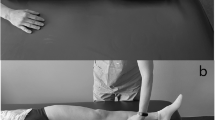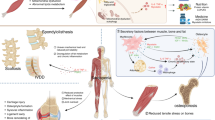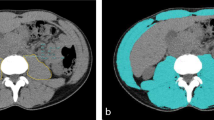Abstract
Study design
Cross-sectional
Objective
To investigate the association between skeletal muscle mass and spasticity in people with spinal cord injury (SCI).
Setting
Tertiary level hospital in Seoul, Korea
Methods
Spasticity was evaluated in 69 participants with SCI using the spasticity sum score (SSS), Penn Spasm Frequency Scale (PSFS), and Spinal Cord Assessment Tool for Spastic Reflexes (SCATS). Skeletal muscle mass was measured using a dual-energy X-ray absorptiometry scanner, and skeletal muscle index was calculated by dividing skeletal muscle mass by height squared. Laboratory parameters including hemoglobin, albumin, creatinine, fasting glucose, and cholesterol were measured. Spearman’s correlation analysis was performed to assess the association between the skeletal muscle mass and spasticity scales. Multiple linear regression analysis was used to present the independent association between them.
Results
The participants’ mean age was 41.8 years; 54 (78.3%) were male, and 46 (66.7%) were tetraplegic. Skeletal muscle index of lower extremities was significantly correlated with all spasticity scales. Spearman’s correlation coefficients were 0.468, 0.467, 0.555, 0.506, and 0.474 for SSS, PSFS, SCATS clonus, SCATS flexor, and SCATS extensor with p-values < 0.001, respectively. After adjustment for age, sex, level of injury, body mass index, and serum creatinine, all spasticity scales were significantly associated with skeletal muscle index of lower extremities in multiple regression analysis. Standardized coefficients were 0.228, 0.274, 0.294, 0.210, and 0.227 for SSS, PSFS, SCATS clonus, SCATS flexor, and SCATS extensor.
Conclusions
Spasticity was significantly correlated with the skeletal muscle mass even after adjusting for possible confounders. Spasticity may need to be considered as an influencing factor in interventions such as electrical stimulation to preserve skeletal muscle mass.
Similar content being viewed by others
Log in or create a free account to read this content
Gain free access to this article, as well as selected content from this journal and more on nature.com
or
References
Sköld C, Levi R, Seiger A. Spasticity after traumatic spinal cord injury: nature, severity, and location. Arch Phys Med Rehabil. 1999;80:1548–57.
Maynard FM, Karunas RS, Waring WP. Epidemiology of spasticity following traumatic spinal cord injury. Arch Phys Med Rehabil. 1990;71:566–9.
Adams MM, Hicks AL. Spasticity after spinal cord injury. Spinal Cord. 2005;43:577–86.
Burchiel KJ, Hsu FP. Pain and spasticity after spinal cord injury: mechanisms and treatment. Spine. 2001;26:S146–S160.
Jozefczyk PB. The management of focal spasticity. Clin Neuropharmacol. 2002;25:158–73.
Castro MJ, Apple DF Jr, Staron RS, Campos GE, Dudley GA. Influence of complete spinal cord injury on skeletal muscle within 6 mo of injury. J Appl Physiol. 1999;86:350–8.
Gorgey AS, Dudley GA. Skeletal muscle atrophy and increased intramuscular fat after incomplete spinal cord injury. Spinal Cord. 2007;45:304–9.
Bauman WA, Spungen AM. Carbohydrate and lipid metabolism in chronic spinal cord injury. J Spinal Cord Med. 2001;24:266–77.
Baldi JC, Jackson RD, Moraille R, Mysiw WJ. Muscle atrophy is prevented in patients with acute spinal cord injury using functional electrical stimulation. Spinal Cord. 1998;36:463–9.
Gorgey AS, Chiodo AE, Zemper ED, Hornyak JE, Rodriguez GM, Gater DR. Relationship of spasticity to soft tissue body composition and the metabolic profile in Persons with chronic motor complete spinal cord injury. J Spinal Cord Med. 2010;33:6–15.
Gorgey AS, Dudley GA. Spasticity may defend skeletal muscle size and composition after incomplete spinal cord injury. Spinal Cord. 2008;46:96–102.
Pandyan AD, Johnson GR, Price CI, Curless RH, Barnes MP, Rodgers H. A review of the properties and limitations of the Ashworth and modified Ashworth Scales as measures of spasticity. Clin Rehabil. 1999;13:373–83.
Penn RD, Savoy SM, Corcos D, Latash M, Gottlieb G, Parke B, et al. Intrathecal baclofen for severe spinal spasticity. N Engl J Med. 1989;320:1517–21.
Benz EN, Hornby TG, Bode RK, Scheidt RA, Schmit BD. A physiologically based clinical measure for spastic reflexes in spinal cord injury. Arch Phys Med Rehabil. 2005;86:52–59.
Hagenbach U, Luz S, Ghafoor N, Berger JM, Grotenhermen F, Brenneisen R, et al. The treatment of spasticity with Δ9-tetrahydrocannabinol in persons with spinal cord injury. Spinal Cord. 2007;45:551–62.
Mills PB, Vakil AP, Phillips C, Kei L, Kwon BK. Intra-rater and inter-rater reliability of the Penn Spasm Frequency Scale in People with chronic traumatic spinal cord injury. Spinal Cord. 2018;56:569–74.
Heymsfield SB, Smith R, Aulet M, Bensen B, Lichtman S, Wang J, et al. Appendicular skeletal muscle mass: Measurement by dual-photon absorptiometry. Am J Clin Nutr. 1990;52:214–8.
Cruz-Jentoft AJ, Baeyens JP, Bauer JM, Boirie Y, Cederholm T, Landi F, et al. Sarcopenia: European consensus on definition and diagnosis: Report of the European Working Group on Sarcopenia in Older People. Age Ageing. 2010;39:412–23.
Lance JW. The control of muscle tone, reflexes, and movement: Robert Wartenbeg Lecture. Neurology. 1980;30:1303–13.
Harris RL, Putman CT, Rank M, Sanelli L, Bennett DJ. Spastic tail muscles recover from myofiber atrophy and myosin heavy chain transformations in chronic spinal rats. J Neurophysiol. 2007;97:1040–51.
Harris RL, Bobet J, Sanelli L, Bennett DJ. Tail muscles become slow but fatigable in chronic sacral spinal rats with spasticity. J Neurophysiol. 2006;95:1124–33.
Kim YS, Lee Y, Chung YS, Lee DJ, Joo NS, Hong D, et al. Prevalence of sarcopenia and sarcopenic obesity in the Korean population based on the fourth Korean National Health and Nutritional Examination Surveys. J Gerontol A Biol Sci Med Sci. 2012;67:1107–13.
Gorgey A, Dudley G. Skeletal muscle atrophy and increased intramuscular fat after incomplete spinal cord injury. Spinal Cord. 2007;45:304–9.
Gallagher D, Heymsfield SB, Heo M, Jebb SA, Murgatroyd PR, Sakamoto Y. Healthy percentage body fat ranges: An approach for developing guidelines based on body mass index. Am J Clin Nutr. 2000;72:694–701.
Yun JH, Chun SM, Kim JC, Shin HI Obesity cutoff values in Korean men with motor complete spinal cord injury: body mass index and waist circumference. Spinal Cord 2018; e-pub ahead of print 2018; https://doi.org/10.1038/s41393-018-0172-1.
Addison O, Marcus RL, Lastayo PC, Ryan AS. Intermuscular fat: A review of the consequences and causes. Int J Endocrinol. 2014;2014:309570.
Qin W, Bauman WA, Cardozo C. Bone and muscle loss after spinal cord injury: Organ interactions. Ann N Y Acad Sci. 2010;1211:66–84.
Shojaei MH, Alavinia SM, Craven BC. Management of obesity after spinal cord injury: a systematic review. J Spinal Cord Med. 2017;40:783–94.
Panisset MG, Galea MP, El-Ansary D. Does early exercise attenuate muscle atrophy or bone loss after spinal cord injury? Spinal Cord. 2016;54:84–92.
Hicks AL, Martin Ginis KA, Pelletier CA, Ditor DS, Foulon B, Wolfe DL. The effects of exercise training on physical capacity, strength, body composition and functional performance among adults with spinal cord injury: a systematic review. Spinal Cord. 2011;49:1103–27.
Rosenberg IH. Sarcopenia: origins and clinical relevance. J Nutr. 1997;127:990S–991S.
Shafiee G, Keshtkar A, Soltani A, Ahadi Z, Larijani B, Heshmat R. Prevalence of sarcopenia in the world: A systematic review and meta- analysis of general population studies. J Diabetes Metab Disord. 2017;16:21.
Dennison EM, Sayer AA, Cooper C. Epidemiology of sarcopenia and insight into possible therapeutic targets. Nat Rev Rheumatol. 2017;13:340–7.
Beaudart C, Dawson A, Shaw SC, Harvey NC, Kanis JA, Binkley N, et al. Nutrition and physical activity in the prevention and treatment of sarcopenia: systematic review. Osteoporos Int. 2017;28:1817–33.
Webber CE. Reproducibility of DXA measurements of bone mineral and body composition: Application to routine clinical measurements. In: Preedy V, (eds). Handbook of Anthropometry. New York: Springer; 2012. p. 151–65. pp
Panisset MG, Desneves K, Ward LC, Rafferty J, Rodi H, Roff G, et al. Bedside quantification of fat-free mass in acute spinal cord injury using bioelectrical impedance analysis: a psychometric study. Spinal Cord. 2018;56:355–65.
Acknowledgements
This study was supported by the Bio & Medical Technology Development Program of the National Research Foundation of Korea.
Funding
This study was funded by the Ministry of Science, ICT and Future Planning (2013R1A1A2010246).
Author contributions
SW Cha was responsible for designing the study, collecting data, extracting and analyzing data, interpreting results, creating the figures, and writing the report. He contributed to designing the study and collecting data. JH Yun was responsible for designing the study and collecting data. He also contributed to interpreting the results. YH Myong was responsible for collecting data and writing the report. He also contributed to interpreting results and updating reference lists. HI Shin was responsible for designing the study, collecting data, interpreting the results, and writing the report. He also provided feedback on the report and approved the final version.
Author information
Authors and Affiliations
Corresponding author
Ethics declarations
Conflict of interest
The authors declare that they have no conflict of interest.
Ethicalal approval
We certify that all applicable institutional and governmental regulations concerning the ethical use of human volunteers were followed during the course of this research. The study was approved by the Institutional Review Board of Seoul National University Hospital (IRB No. 1412–115–634), and written informed consent was obtained from all study volunteers.
Rights and permissions
About this article
Cite this article
Cha, S., Yun, JH., Myong, Y. et al. Spasticity and preservation of skeletal muscle mass in people with spinal cord injury. Spinal Cord 57, 317–323 (2019). https://doi.org/10.1038/s41393-018-0228-2
Received:
Revised:
Accepted:
Published:
Issue date:
DOI: https://doi.org/10.1038/s41393-018-0228-2
This article is cited by
-
Denervation impacts muscle quality and knee bone mineral density after spinal cord injury
Spinal Cord (2023)
-
Spasticity Management After Spinal Cord Injury
Current Physical Medicine and Rehabilitation Reports (2020)



